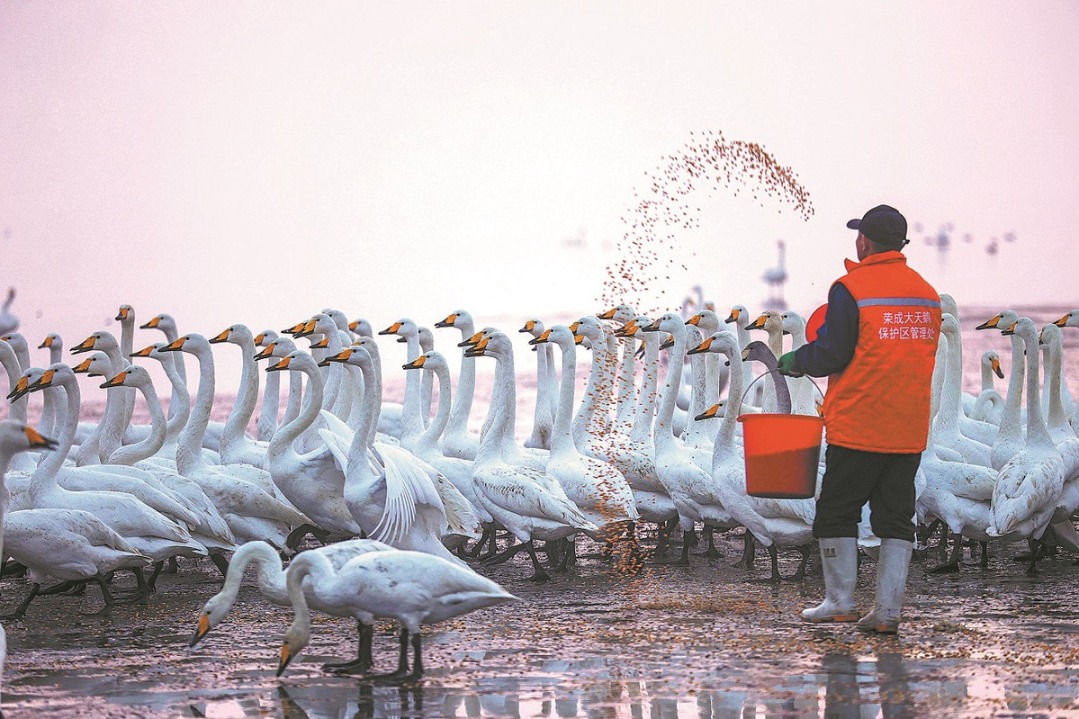Bird photographers feather villagers' nests

ZHENGZHOU — At the edge of a pond, a cluster of cameras focus on a long-tailed bird perched on a tree. As it dives in and out of the water, the photographers, who have waited all day for this moment, celebrate their shots.
Some of them arrived in Hongtang village, Luoshan county, in Henan province as early as 2:30 am to capture the sight. They have come from all over, some even traveling from cities such as Beijing and Shanghai, to perch inside a building that was once a pigsty.
The makeshift lookout was built by Chen Fujin next to his pondside home. Previously, the pigsty and the manure it produced, was a concern for the community, especially during the summer when it attracted swarms of flies.
In response to complaints, Chen stopped pig farming in 2019 but when the following year, a pair of Asian Paradise flycatchers nested in the trees by the pond, he earned more from them than he ever did from raising pigs.
Each spot in the lookout costs 100 yuan ($13.9) a day, and it is always packed during peak birdwatching season between May and July. The Asian Paradise flycatchers have been breeding there for four years now. "This bird's nest has become a 'golden nest' for my family," Chen said.
Hongtang village sits on the edge of the Henan Dongzhai National Nature Reserve. Spread over 46,800 hectares, the reserve is a sanctuary for 334 bird species, including 74 that are nationally protected. Among them are rare species such as the crested ibis, the Reeves's pheasant, and the Asian Paradise flycatcher.
Before the founding of the People's Republic of China, the land here was severely deforested as a result of war and farming. A state-owned forest farm was set up in 1955, beginning the process of environmental restoration. Several generations later, a thriving forest ecosystem has emerged, rich in biodiversity and home to 23 percent of China's bird species, and the reserve is now regarded as a bird paradise.
The change caught the eye of Guo Mingpeng. He worked for a few years in the city after graduation. Then he decided to follow in his father's footsteps and became a professional bird guide in 2015. His team now organizes bird-watching tours, guiding over 20,000 visitors around the area every year.
The bird-watchers not only contribute to conservation awareness but also to the local economy, significantly boosting the income of villagers through their patronage of homestays, eateries, and tours.
"The public awareness of bird protection has improved, with only a few cases of hunting or harm to birds reported," Guo said. "So in recent years, many more birds have been attracted to the village, possibly because of an abundance of food sources, or because of the continuous expansion of the population."
Huang Zhixue, an engineer at the crested ibis breeding station in the reserve, echoed this view. "We have received many phone calls from the public to report trapped crested ibis or other birds. We have limited staff, so we have to rely on the public to protect them," Huang said.
Guo noted that bird photographers have deep pockets, typically spending at least 300 yuan a day on meals, lodging, and photography. As a result, the number of agri-tainment offerings and homestays is increasing.
Dongqiao, which is in Luoshan county, was once a poor mountain village, but has since become famous as a place to photograph the Reeve's pheasant and the crested ibis. Since 2010, 10 farmers have become bird guides, and the village has created 13 agri-tainment offerings and six homestays. Many villagers have found prosperity as a result of this bird-focused economy.
According to Duan Wenke, the founder of birdnet.cn, a popular website for bird photography, bird-watching has grown explosively in China in recent years.
Three of the eight main global bird migration routes pass through China, which is also home to one of the most diverse ranges of bird species in the world. Some 1,400 have been discovered so far, 394 of them nationally protected. "There are around 1,000 fixed bird-watching spots and bird-watching associations or organizations have been set up where conditions are favorable," Duan said. This thriving bird economy has transformed many remote mountain villages into tourist destinations.
Baihualing village in Yunnan province, which was relatively unknown 20 years ago, is home to around 300 bird species that breed between October and May, and has become a popular bird-watching center both nationally and internationally. "Birds have memories. If you protect their habitat, they will return the following year. If you destroy it, they won't," Duan said. "So, local residents greatly emphasize environmental protection. It's the only way to create a virtuous cycle of achieving a balance between protection and development."
Xinhua
- New China-Vietnam air route boosts links with ASEAN
- Beijing's Daxing airport sets a new record in passenger trips
- China and France hold joint forum on higher education
- Dinosaur footprints from about 200m years ago found in China
- Free shuttles provided for residents affected by Tai Po fire to vote
- Global influencers unlock scenic and cultural charms of Hechi



































